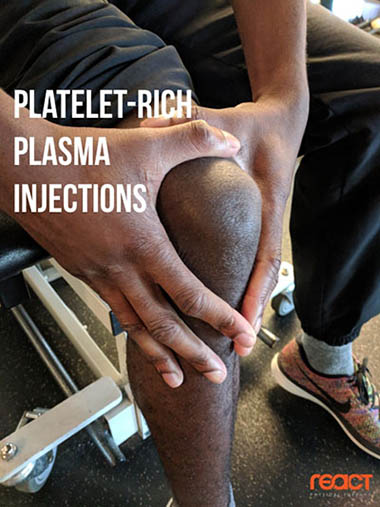Platelet-Rich Plasma Injections

During my time working as a physical therapist, I have heard from multiple patients about platelet-rich plasma injections (PRP) for their knee and hamstring issues. You may have heard of athletes like Kobe Bryant and Tiger Woods pursuing this treatment as well, so I decided to take a look into both its process and potential benefits for our patients as they recover from their pain.
What is PRP?
During the process of PRP, blood is drawn from the patient and centrifuged, separating and increasing the concentration of platelets in the blood. This more concentrated blood is injected back into the body in specific locations with the idea being that the higher concentration of platelets will assist with the healing process of tissues such as muscles, cartilage, tendons, and ligaments.
What is the research backing PRP injections in the knee and hamstring?
Knee
In the knee, PRP is often used for degenerative conditions like osteoarthritis or the general wearing away of cartilage and meniscus that protects the bones of the knee during weight-bearing activity. A systemic analysis that looked at multiple studies found that PRP injections for knee degenerative pathology “showed continual efficacy for 12 months” in comparison to their pre-injection state and added that those with less severe degeneration responded better. It also provided better and more prolonged effects compared to hyaluronic acid, another common treatment for knee degenerative conditions.
Hamstring
There is conflicting evidence regarding PRP injections to treat hamstring strains and improve pain and function; however, the larger studies that have been done show little to no benefit to the treatment compared to rehab alone.
Safety
Literature states that adverse reactions are rare due to your own blood being used for the injections. Pain during and after the injections can occur, and scar formation and calcification are possible. You should not get PRP injections if you have cancer or metastatic disease, an active infection, low platelet count, or if you are pregnant or breastfeeding.
Conclusion
PRP is a relatively invasive treatment that also may require a rest period of 3 days before you can return to your physical therapy appointments for a particular area. When you return to therapy, you will likely begin with a gentle range of motion and protection of the joint for a week or two before returning to resistance activity. Return to sport or prior function normally occurs around the 4-week mark. Though it is generally preferable to attempt conservative management before pursuing more invasive interventions, should your pain and function not improve over the course of 6 to 8 weeks of therapy, PRP is an option that can benefit certain populations when combined with a rehabilitation program.
References
Chang, K. V., Hung, C. Y., Aliwarga, F., Wang, T. G., Han, D. S., & Chen, W. S. (2014). Comparative effectiveness of platelet-rich plasma injections for treating knee joint cartilage degenerative pathology: a systematic review and meta-analysis. Archives of physical medicine and rehabilitation, 95(3), 562-575.
Manduca, M. L., & Straub, S. J. (2017). Effectiveness of PRP Injection in Reducing Recovery Time of Acute Hamstring Injury: A Critically Appraised Topic. Journal of sport rehabilitation, 1-19.
Everts P, Knape J, Weirich G, Schonberger J, Hoffman J, Overdevest E, et al. Platelet-rich plasma and platelet gel: a review. JECT. 2006;38:174–87.
Sampson S, Gerhardt M, Mandelbaum B. Platelet rich plasma injection grafts for musculoskeletal injuries: a review. Curr Rev Musculoskelet Med. 2008 Dec;1(3-4):165-74.
Yamashiro, Kyle M. (2014). Platelet Rich Plasma – PRP Rehabilitation. http://athleticmed.com/wp-content/uploads/2014/02/PRPRehabiltation-final.pdf